 Polishing boats protected with gelcoat is not as unnecessary you might think. Regular maintenance is paramount both for yachts and for ordinary boats. Maintaining good appearance is one thing, but you also need to protect the boat for more down to earth reasons. The best of polishing pastes retain the value of your boat with the latest polishing technologies. They will protect the gelcoat from environmental damage. That includes sea salt, dirt, ultraviolet rays, and everything else.
Polishing boats protected with gelcoat is not as unnecessary you might think. Regular maintenance is paramount both for yachts and for ordinary boats. Maintaining good appearance is one thing, but you also need to protect the boat for more down to earth reasons. The best of polishing pastes retain the value of your boat with the latest polishing technologies. They will protect the gelcoat from environmental damage. That includes sea salt, dirt, ultraviolet rays, and everything else.
But wait, doesn’t wax do the same thing? That’s right, but while applying synthetic pastes is still waxing, they do not contain the original wax, which is why you will not find any wax products in this review. But there’s no need to be upset about that. First, I also have a review on waxes, second, synthetic compounds can sometimes deliver better results than natural products. After all, your boat is not a pet you need to fee or give supplements to, she doesn’t need natural products to function. Most of the time, it’s quite the opposite, in fact.
Also, the wax is applied after a polishing compound sometimes.
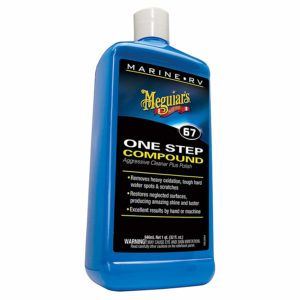
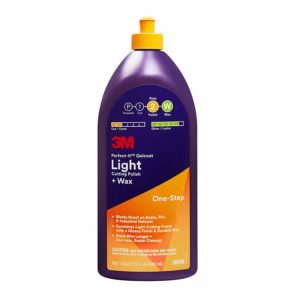
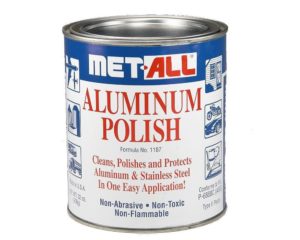
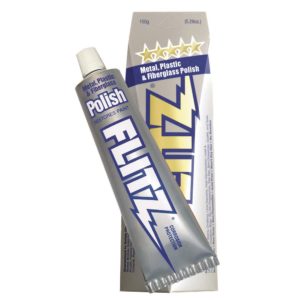
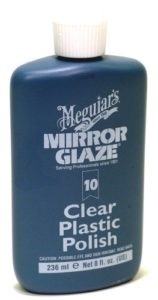
Top 5 Best Boat Polishes in 2019
1Meguiar's M6732 One Step Compound — One Step Polish
Use this Meguriar’s compound when you need the heavy lifting done in one step. Obviously, it’s not meant for situations where you only want to do some touch-up job. As I said, it’s a heavy lifter, so it’s better to treat it like one.
It’s a cutting formula that is perfect for removing oxidation from gelcoat and renewing its glossiness. It also provides excellent results with bare fiberglass.
The One-Step compound is genuinely a one-step for all. It cleans, cuts, polishes and seals, all in one step. Basically, it saves you a lot of time.
Is it better than using three different compounds consecutively? No, actually it’s not. It is more than adequate, but if you need something astounding, then you better do it in consecutive steps properly. I’m not saying the One Step compound isn’t useful, because it is. But if you expect more than 90% of people do, you might have to consider other options. After all, if you do everything in several steps, you can run some quality evaluation after each, and that’s a lot harder to backtrack when all it takes is a single step.
It’s a magnificent compound, and I recommend it for anyone who has a fiberglass boat and wants to save some money and time.
- Easy oxidation removal. Because this compound is aggressive, it doesn’t take long to remove anything that you don’t want.
- All-in-one. While some people are specifically irritated by any all-in-ones, this one is more than good when it comes to polishing.
- Tailored for fiberglass and gelcoat. Using this compound on anything else is not guaranteed to deliver the best results, but if it's the, everything's fine.
- Abrasive. It's an aggressive compound, and it's not fit for use on aluminum and most painted boats. It's also not really needed for fiberglass boats with just some oxidation. Granted, it's not too bad a con if you need some heavy work done on your boat.
- Not a dedicated polish. Although it's more than adequate as an all-in-one solution, those tend to be less effective or convenient than specialized tools.
- Risk of decomposition. At least a few customers complained that the product arrived broken down into liquid and gooey components. I haven’t experienced the same, but it can happen.
23M Perfect-It Gelcoat Light Cutting Polish + Wax — Best Polish with Wax
If we’re going to talk about heavy hitters, I can’t help but bring this one up. Why, it’s so good I can barely resist using bad language to describe this beauty.
Before I say anything else, I’ll have you know that this particular compound is part of an entire product line made for boat care. This is a stage 2, polish (and also some wax), but they also have a pre-cleaner, a cutting compound that has more abrasive power than some sandpaper this polish and finally a dedicated wax for ultra-high gloss.
If your case of oxidation is terrible, you need to get their stage 1 compound. I guarantee that it’s going to impress you, as long as it’s shipped to you intact. Nothing cuts like that thing. Including this polish, admittedly.
In fact, it’s not very strong as far as cutting compounds go. But it’s a polish, so that’s hardly a bad thing.
3M is one of the best and most recognized brands in the world. It’s a pro-grade brand, and it makes pro-grade compounds. And it’s great.
The only thing I have against this polish is that it’s mostly useful for fiberglass and gelcoat. It’s not designed for anything else, although it’s applicable.
- Effortless oxidation removal. It's a fast-cutting compound, and it shows. Perfect for removing oxidation.
- Includes wax. You can polish your boat, and that’s it, it’s as good as waxing.
- Tailored for fiberglass and gelcoat. It’s not designed for anything else. Not a general purpose tool by any stretch
- Abrasive. It’s a fast cutting compound that’s only made for fiberglass boats and RVs.
- Not designed for anything other than fiberglass. Partly due to the abrasiveness, partly because of the strategy.
3Met-All Aluminum Polish — Best for Aluminum
Abrasive polishes won’t get you far. They can only do so much, they are destructive polishes, they are only suitable for some materials, and even then they are meant for particularly nasty cases of scratches, oxidation, and burnout. They work by removing the top layer of the gelcoat or other material, revealing the shiny yet untouched layers underneath. Sometimes, you don’t need to do that, sometimes, you don’t want to do that.
Enter the Aluminum Polish. It is non-abrasive, so it is the polish to use when you need to polish metal surfaces, aluminum, and its alloys first, of course, but also others. The best part it’s not just metals, the polish works on fiberglass and plexiglass, and that’s what makes it perfect for any boat owner.
You can use this polish more than just for your boat. Your car? You got it. Got a plane you want to polish? No problem. Cookware? Kitchen utensils? Anything in your home that needs that high gloss? Go ahead. It’s truly a multi-purpose polish. With it, you won’t need several dedicated polishes to work on your boat. You can use this polish for the hull, for the windshield and even for the seats, the metal parts, anyways.
- Protection. While it’s no wax, the compound does offer some protection against water spots and oxidation.
- Multi-purpose. With this polishing paste, you can polish almost any type of surface that you want. It is specially designed for some metals and alloys known for their glossiness and also fiberglass and plexiglass.
- Safe for kitchen utensils. The paste is entirely non-toxic and non-abrasive, and that makes the range of possible uses so much more extensive.
- No fire hazard. The Met-All aluminum polish is explicitly non-flammable.
- High luster. All that needs to be said.
- Possible shipment problems. The compound is shipped in a can that is seemingly not designed to take the abuse of rough handling. The lid may come off if the package is thrown around too much.
4Cream Polish Flitz150gm — Best for Fixing Spots
First things first. For an entire boat, this little tube is not large enough. Even if your boat is small, you have to purchase a few extras to run through them as you keep polishing. But it’s great for a patch-up job, and it’s also great for working on some parts that need some love and luster rather than trying to polish the entire hull. Which you can do if your boat is small and you have quite a few tubes on hand, Given how expensive that would be, I somehow doubt you would go for that option.
It is very similar to the Met-All aluminum polish. The difference is that the Met-All product can handle black spots despite being non-abrasive, even though it takes time, and this product is less suitable for that. It does remove black stains, but you should realize that you’re in for a lot of elbow grease. I suppose a power buffer could help, but the tube doesn’t have a lot of paste to make unpacking the buffer worth it.
- Multi-purpose. A truly all-around product that you can use on anything.
- Safe for kitchen utensils.If that's what you want to do. Non-toxic and non-abrasive is what it takes. Works great on stainless steel.
- No fire hazard. The Flitz polish is also non-flammable.
- Protection. The compound offers some protection against corrosion.
- Bad at removing black stains. You can polish a part of your boat to be all glossy and look like a mirror, but if there were black spots, they are going to stay. You need to remove them with something else or work for hours to get rid of them.
- Small tube. You can’t work on your entire boat with it, it’s not big enough for that.
5Meguiar's Clear Plastic Polish — Best for Windshields
This polish is not suitable for polishing your boat as such. It is, however, ideal for plastics, particularly, transparent plastics. If you want to work on your plexiglass windshield, this is the product to take.
Unfortunately, it’s no good for anything other than plastics. It’s a one-purpose product, and you can’t use it on any other part of the boat. That sucks, but it’s true.
On the bright side, this polish is excellent when you’re using it for what it’s intended for. Windshields are not the only thing it’s great for. It’s also great for restoring instrument panel covers (which are typically made of transparent plastics rather than glass), navigation lights and lots of other things.
It’s only tangentially related to boat care, but then it’s very good at what it does.
- Removes light scratches. Since plastics are soft, you don’t need abrasive materials to get rid of scratches.
- Superb glaze. When that’s part of the name, we should expect other results.
- The best polishing compound for plastics. It’s a dedicated polish, that’s hardly a surprise.
- Not for the hull. Irritatingly so. It's only meant for clear plastics. But it's good when that's exactly what you need for your boat.
Buyer’s Guide
Abrasive vs. Non-Abrasive
When purchasing a polish, it is paramount to consider if you need an abrasive or non-abrasive polish. Non-abrasive polishes can be applied to a variety of surfaces, regardless of the purpose. Abrasive polishes have a minimal range of applications.I recommend using them for fiberglass boats only in most cases, and even then it’s only needed for a nasty case of oxidation, where you need to cut a lot of gelcoat to hide the numerous defects. Basically, the worse it looks, the more abrasive power you need. If the boat looks just horrible, it might be better to sand it well first and proceed to a regular polish after that.If you still need to use an abrasive polish, then you’ll still have to use a non-abrasive polish or wax in most cases, to apply the final protective coat. The reason you need that is that the primary function of an abrasive polish is to remove the defects rather than protect the surface of your boat. Abrasive polishes literally cut the surface of your boat, destroying the surface layer of gelcoat, and therefore they are not to be used as the final coat. There are a few exceptions, but it’s easier just do two things rather than one.Protection
Aside from removing and hiding the minor defects, the main reason for why a polish is needed at all is the protection of the hull from the following harmful factors:- Ultraviolet radiation. Bright sunlight causes the gelcoat exposed to UV radiation without any sort of protection to lose its original color. A polish can help with that.
- Sea salt. A never ending problem. Sea salt is extremely corrosive, and protection should never be neglected.
- Dirt and stains. How can someone get their boat all dirty and strained at sea? Believe me, there’s more than one way. Regardless of how people get their boats all greasy, it can be prevented with a polish. It doesn’t even matter if it bonds with the gelcoat or not, the polish is enough to isolated the hull from absorbing the stains and the like.
- Mechanical damage. Happens all the time, main inshore, although colliding with floating debris from storm aftermath can happen far in the open sea.
